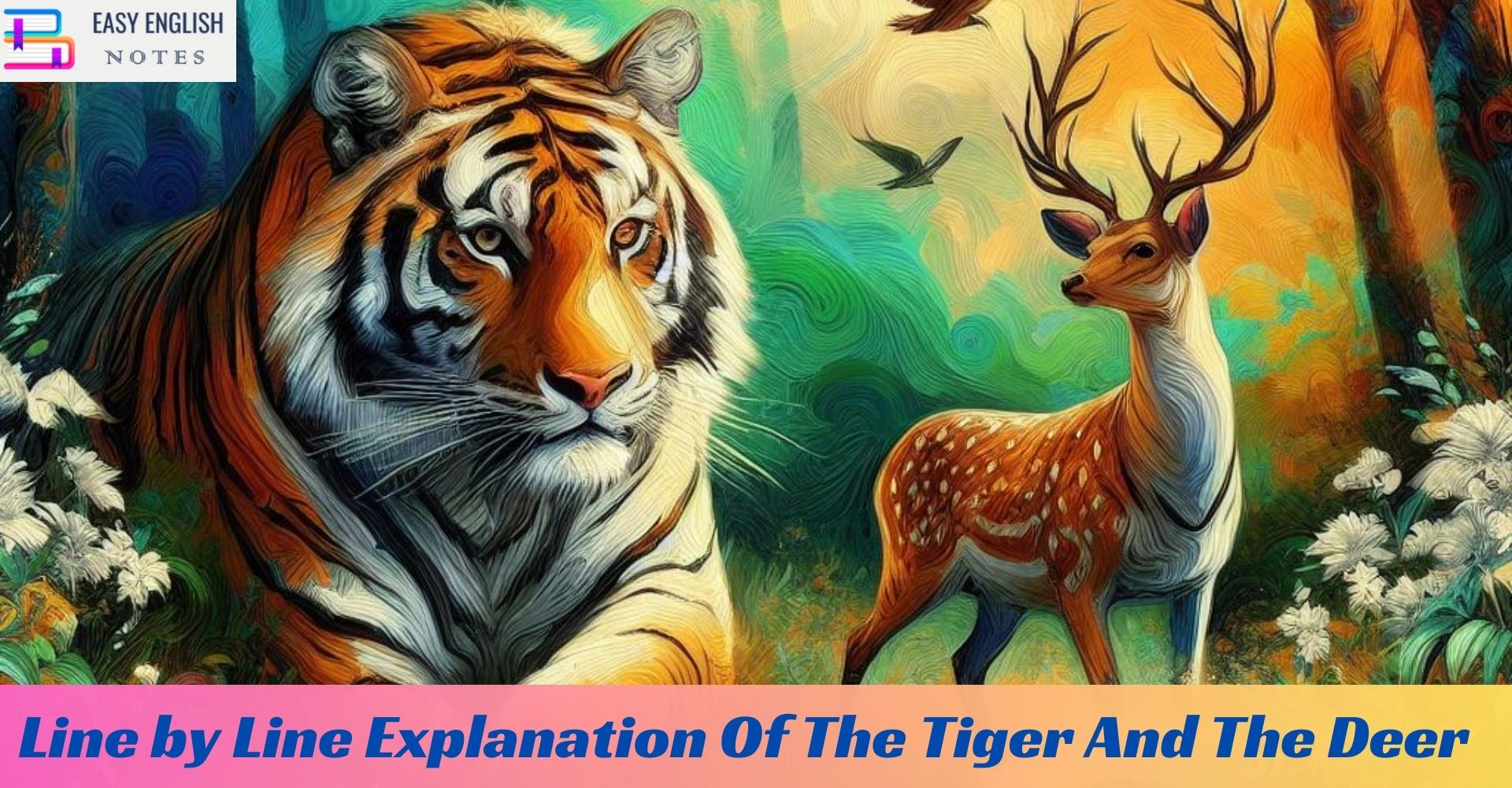“The Tiger and the Deer” by Sri Aurobindo crafts a vivid tableau that mirrors the profound and often brutal truths of nature and existence. Through its lines, the poem navigates the themes of beauty, cruelty, mortality, and the cyclical nature of life. Here’s an exploration of its imagery and themes, line by line:
Line by Line Explanation
Brilliant, crouching, slouching, what crept through the green heart of the forest,
- The poem opens with a portrayal of a tiger moving stealthily through the forest. The use of “Brilliant” captures the majestic and awe-inspiring aspect of the tiger, while “crouching, slouching” evokes its predatory nature.
Gleaming eyes and mighty chest and soft soundless paws of grandeur and murder?
- These lines further develop the tiger’s description, emphasizing its powerful physique and the silent, deadly intent in its movements. The juxtaposition of “grandeur and murder” highlights the dual nature of the tiger as both a magnificent and a lethal creature.
The wind slipped through the leaves as if afraid lest its voice and the noise of its steps perturb the pitiless Splendour,
Google Ads PPC Training Digital – membership area
An Exclusive Blood Sugar Balancing And Weight Loss
- The personification of the wind suggests a reverence for the tiger, so potent that even natural elements tread lightly to avoid disturbing it. “Pitiless Splendour” encapsulates the tiger’s majestic yet merciless essence.
Hardly daring to breathe. But the great beast crouched and crept, and crept and crouched a last time, noiseless, fatal,
- The anticipation of the hunt is palpable, with the tiger’s movements described as both deliberate and deadly. The repetition of “crept and crouched” builds tension, leading to the imminent attack.
Till suddenly death leaped on the beautiful wild deer as it drank
- The moment of attack is abrupt, marking the transition from life to death for the deer. The deer is portrayed in a moment of vulnerability, emphasizing the cruelty and suddenness of nature’s law.
Unsuspecting from the great pool in the forest’s coolness and shadow,
- This line paints a serene picture of the setting, contrasting sharply with the violence of the act. The deer’s unawareness underscores the unpredictable nature of death.
And it fell and, torn, died remembering its mate left sole in the deep woodland, –
- The deer’s final thoughts are of its mate, adding a poignant layer to the narrative. This line humanizes the deer, invoking empathy for its plight and highlighting the emotional consequences of the survival instinct.
Destroyed, the mild harmless beauty by the strong cruel beauty in Nature.
Also Read :
- Compare Hamlet with Macbeth, Othello and other Tragedies
- “The Pardoner’s Tale” is the finest tale of Chaucer
- Prologue to Canterbury Tales – (Short Ques & Ans)
- Confessional Poetry – Definition & meaning
- Line By Line Explanation Of The Poem The Eve of St. Agnes
- The contrast between the deer’s “mild harmless beauty” and the tiger’s “strong cruel beauty” reflects on the inherent dichotomy within nature, where survival often comes at the expense of another life.
But a day may yet come when the tiger crouches and leaps no more in the dangerous heart of the forest,
- This line introduces a prophetic tone, suggesting the eventual end of the tiger’s reign, much like the extinction of the mammoth. It hints at the impermanence of power and predation.
As the mammoth shakes no more the plains of Asia;
- The reference to the extinct mammoth serves as a reminder of the inevitability of change and the cycle of life and death, reinforcing the theme of impermanence.
Still then shall the beautiful wild deer drink from the coolness of great pools in the leaves’ shadow.
- Despite the cycles of predation and extinction, the poem suggests a continuity of life, with the deer symbolizing the resilience and persistence of beauty and gentleness in the face of adversity.
The mighty perish in their might; The slain survive the slayer.
- The concluding lines offer a profound reflection on the transient nature of power. They suggest that in death, the victim transcends the victor, perhaps in memory or in the enduring qualities they represent.
Sri Aurobindo’s “The Tiger and the Deer” weaves a complex narrative of the beauty and brutality of nature, exploring themes of mortality, the cycle of life, and the enduring spirit of the gentle and the meek. Through its vivid imagery and contemplative tone, the poem invites reflection on the deeper currents that underpin existence in the natural world.











